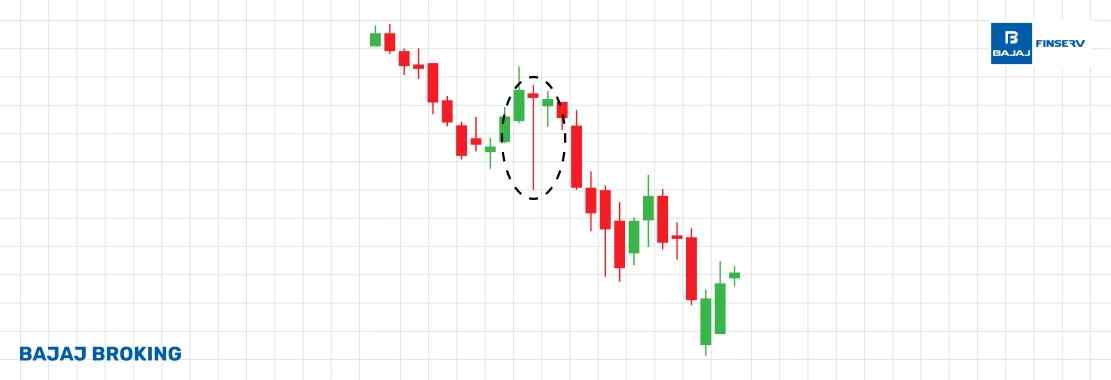With several reversal patterns in the stock market, the Dragonfly Doji candlestick pattern makes for a unique way to gauge potential trend reversals. This reversal could either be bullish or bearish and depends on prior price movements. The Dragonfly Doji forms when a security’s high, open, and close prices are close to being identical. This ends up creating a distinct T-shape on the chart.
The long lower shadow that is cast is an indicator of sellers initially being dominant, driving the prices down, but buyers eventually stepping in and pushing prices back up. This battle to establish a balance of power is what makes the dragonfly doji a unique pattern.
What is Dragonfly Doji Candlestick Pattern?
The Dragonfly Doji is a popular bullish reversal pattern that makes an appearance when a downtrend in the market is coming to an end, signalling a potential price turnaround. With the help of this pattern, traders can spot important demand and support portions. As a result, recognising a potential upward turn can be identified easily. Combining this pattern with other technical indicators will make the result more accurate, too.
One of the unique features of this pattern is its T-shaped candlestick. Here, the open, high, and close prices are very close to being the same. Yes, all three will rarely be the same, but the pattern’s long lower shadow is an indicator of strong buying pressure after an initial sell-off.
Features of the Dragonfly Doji Candlestick Pattern
Here’s a look at some of the features of the Dragonfly Doji Candlestick Pattern:
The formation of the Doji candlestick pattern takes place when the opening and closing prices are almost identical. This produces a non-existent or extremely small real body with shadows.
The shape and form of the Dojis will depend on the market conditions.
Though Dojis can often be a sign of hesitation in the market, that is not always the case. During such times, the formation could also signal a trend reversal.
A majority of the Dojis are formed before a trend shift since they indicate a balance between bullish and bearish forces.
Dojis are not known to provide a clear market direction. This is why they must be analysed ideally with additional technical indicators.
Features of a Green Dragonfly Doji
Here are some of the features of the Green Dragonfly Doji
When the candle closes higher than it opened, it forms a bullish (green) body. This is an indicator that buyers were able to push the market prices up by the end of the trading session.
The long lower shadow indicates that though initially, sellers drove the prices lower, buyers regained control and pushed prices higher.
Since there is no upper shadow, this is an indication that the prices did not rise much above the opening level during the trading session.
How to Read Dragonfly Doji Candlestick?
The main purpose of the Dragonfly Doji patterns is to signal a potential price reversal. The pattern forms when the open, close, and high prices are nearly identical. This ends up creating a T-shaped candlestick that has a long lower shadow and no upper shadow.
The long lower shadow in the pattern indicates that the sellers initially pushed the prices down, but the buyers fought hard and brought the price back up by the end of the session.
When the Dragonfly Doji pattern appears after a downtrend, it indicates a potential price increase. To confirm the same, traders need to keep an eye on the next candlestick, which should close higher, signalling a possible buying opportunity.
However, if the pattern forms after an uptrend, it could indicate a potential drop in prices. To confirm the same, traders need to watch the next candlestick and, if it closes lower, suggest that sellers are taking control.
When there is a bullish setup, traders may enter a long position. By placing a stop loss below the Dragonfly’s low, they will also be able to manage any potential risks. When there is a bearish setup, traders could take a short position. Here, setting a stop loss above the Dragonfly’s high can protect them from a reversal.
Drawbacks of the Dragonfly Doji Candle
Though the Dragonfly Doji is a popular pattern, it does not appear often. But even if it does, the price reversals keep appearing either way. This is specifically why traders mustn’t solely rely on it for recognising reversals.
Traders need to remember that when there is a higher trading volume, the pattern is more trustworthy. However, when the Doji and its confirmation candlestick form with low volume, traders need to recognise that it might be a weak signal. This is why it is better to combine other technical indicators to analyse the situation better.
Since the pattern does not indicate any particular price targets, traders will not know how far the price might move. Hence, the need for additional tools becomes even more crucial.
What is Red Dragonfly Doji Candlestick?
Think of the Red Dragonfly Doji as a slight variation on the Dragonfly Doji. The only difference is that the former has a slightly higher opening price than the closing price. This is what results in a red or bearish candle instead of a green one. However, despite this difference, the basis of both the patterns is the same: a potential reversal.
The key characteristics of the red dragonfly doji include:
The red colour is present because the candle closes lower than it opened.
Like a traditional Dragonfly Doji, the long lower shadow formed indicates the initial push by the sellers to decrease the price, but the buyers brought it back near the opening level.
The prices didn’t rise significantly above the open, which cements the idea that the initial selling pressure was strong.
Here is how the pattern can be interpreted:
Though the candle is red, the buyers can recover from a potential steep drop. This indicates that the selling pressure is fading, indicating an upcoming bullish reversal.
In the pattern, since it is not a standalone signal, traders prefer waiting for a bullish candle after a Red Dragonfly Doji to place an order.
Trading Strategies Using the Dragonfly Doji Candle
Structure of the Dragonfly Doji Candlestick
The best thing about the dragonfly doji candlestick pattern is that it can easily spotted in charts as it has a very distinct structure. Here is a step-by-step breakdown of this structure.
The open price is where the asset starts trading for the session. In this pattern, the open price is usually very similar to the closing price.
The close price is where the asset finishes the session. This is very similar to the open price.
The long lower shadow is one of the most unique traits of the Dragonfly Doji. This indicates that though sellers initially drove the price down, buyers were able to push it back up before the session ended.
A non-existent or a very small upper shadow indicates that the prices didn’t rise much above the open.
Since the open and close prices are almost identical, the body of the pattern is small and appears like a “T” or a cross on the charts.
Effectiveness of Dragonfly Doji in Technical Analysis
Though the dragonfly doji has a strong candlestick pattern, combining it with other analysis tools would be a good idea. Here is a look at the effectiveness of the pattern:
Relying on the Dragonfly Doji alone is not a good idea. It is always better to use other technical tools like moving averages, MACD or RSI to confirm the indications of the pattern.
When there is a high trading volume during the formation of this pattern, it indicates a strong buyer interest.
When the pattern makes an appearance close to a key support level, it adds more credibility to the case for a potential price reversal.
Additional Read: Technical Analysis Guide
Purpose of the Dragonfly Candlestick
The Dragonfly Doji is a popular and important candlestick pattern that helps traders spot potential reversals and understand which way the market is moving. It is important to understand that the pattern is not a guaranteed signal, but it becomes more so when combined with other indicators.
The pattern will often appear at the end of a downtrend, which further suggests that sellers are losing control and buyers are gaining it.
This also indicates a tug-of-war of sorts between buyers and sellers, which ends with a close near the open price.
When there is a bullish confirmation candle forms, traders can go long.
The low of the Dragonfly Doji serves as a smart stop-loss level to manage risk.
The appearance of the pattern near strong support zones is a strong indicator of a price bounce.
When it appears near resistance levels, it indicates a potential selling pressure instead of a reversal.
The pattern works better when combined with tools like moving averages, RSI, Bollinger Bands, or Fibonacci retracements to confirm signals.
The dragonfly doji can also appear within bigger candlestick formations.
Additional Read: What Is a Candlestick Pattern?
Conclusion
The Dragonfly Doji is a popular and strong candlestick pattern that aids traders in spotting potential bullish reversals in the market and understanding the market sentiment. However, like any other tool, it is not perfect or foolproof. This is why, before making a decision based on what it indicates, it is better to combine it with other tools to confirm the same. This will help traders steer clear of making bad investment or trading decisions.
Do you have a trading account app or demat account app?
You can open an account with Bajaj Broking in minutes.
Download the Bajaj Broking app now from Play Store or App Store.
Disclaimer: Investments in the securities market are subject to market risk, read all related documents carefully before investing.
This content is for educational purposes only. Securities quoted are exemplary and not recommendatory.
For All Disclaimers Click Here: https://www.bajajbroking.in/disclaimer













